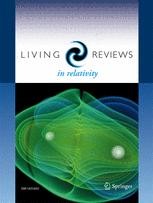Living Reviews in Relativity: "Kilonovae" (Update)
 Metzger, B., "Kilonovae", Living Rev Relativ (2020) 23: 1. https://doi.org/10.1007/s41114-019-0024-0
Metzger, B., "Kilonovae", Living Rev Relativ (2020) 23: 1. https://doi.org/10.1007/s41114-019-0024-0
Open Access | Review Article
Published: 16 December 2019
Major revision, updated and expanded version of
https://doi.org/10.1007/s41114-017-0006-z.
"The author significantly revises the previous manuscript, which was written before the discovery of GW170817. The current manuscript extensively overviews what we have learned from GW170817 and includes a tremendous number of new papers published after the event. I appreciate the author's effort to update the review article and highly recommend this to be accepted in Living Reviews in Relativity. [Referee]"
Abstract:
The coalescence of double neutron star (NS–NS) and black hole (BH)–NS binaries are prime sources of gravitational waves (GW) for Advanced LIGO/Virgo and future ground-based detectors. Neutron-rich matter released from such events undergoes rapid neutron capture (r-process) nucleosynthesis as it decompresses into space, enriching our universe with rare heavy elements like gold and platinum. Radioactive decay of these unstable nuclei powers a rapidly evolving, approximately isotropic thermal transient known as a “kilonova”, which probes the physical conditions during the merger and its aftermath. Here I review the history and physics of kilonovae, leading to the current paradigm of day-timescale emission at optical wavelengths from lanthanide-free components of the ejecta, followed by week-long emission with a spectral peak in the near-infrared (NIR). These theoretical predictions, as compiled in the original version of this review, were largely confirmed by the transient optical/NIR counterpart discovered to the first NS–NS merger, GW170817, discovered by LIGO/Virgo. Using a simple light curve model to illustrate the essential physical processes and their application to GW170817, I then introduce important variations about the standard picture which may be observable in future mergers. These include ∼hour-long UV precursor emission, powered by the decay of free neutrons in the outermost ejecta layers or shock-heating of the ejecta by a delayed ultra-relativistic outflow; and enhancement of the luminosity from a long-lived central engine, such as an accreting BH or millisecond magnetar. Joint GW and kilonova observations of GW170817 and future events provide a new avenue to constrain the astrophysical origin of the r-process elements and the equation of state of dense nuclear matter.
Changes:
Major revision, updated and expanded. Overall, the main changes were to 1) blend into the discussion GW170817 in many places; 2) substantially update the reference list in light of all the work post-170817; 3) re-worked the organization slightly, focusing in Sect. 4 on what aspects of the models largely confirmed in 170817 (blue/red kilonova) and making a new Sect. 6 on future speculations.
The Author:
Brian D. Metzger is an Associate Professor in the Department of Physics at Columbia University, New York. His research is in theoretical high energy astrophysics, on topics including gamma-ray bursts, novae, supernovae, accretion processes, shocks, compact objects, nucleosynthesis (astrophysical origin of the elements), and the electromagnetic counterparts of gravitational-wave sources. His research utilizes both analytic calculations and numerical simulations, with the latter often pursued in collaboration with students and postdocs.
